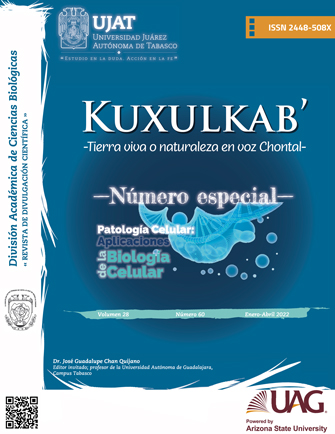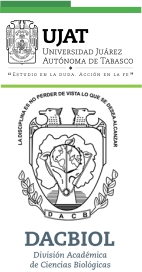CELLULAR EFFECTS OF EXPOSURE TO PLASTIC MICROPARTICLES IN AQUATIC ORGANISMS
DOI:
https://doi.org/10.19136/kuxulkab.a28n60.4667Keywords:
Cellular damage, Microplastics, Aquatic organisms, Fish, InvertebratesAbstract
Microplastics and nanoplastics are among the most widely distributed pollutants globally and currently concern humanity, mainly because of their durability and the adverse effects it shows in different organisms, both in terrestrial and aquatic environments. It has been shown in laboratory studies that plastics of various types, either simply or in combination with other toxic compounds or elements, elicit potentially harmful responses at the cellular level, such as cell membrane lysis, modulation of membrane receptors, changes in membrane potentials, alterations in permeability, mitochondrial damage, changes in metabolic activities, generation of reactive oxygen species, genotoxicity, DNA damage and apoptosis. However, our knowledge about the effects of microplastics concentrations in the natural environment needs to be improved.
Downloads
References
Ahrendt, C.; Perez-Venegas, D.J.; Urbina, M.; Gonzalez, C.; Echeveste, P.; Aldana, M.; Pulgar J. & Galbán-Malagón, C. (2020). Microplastic ingestion cause intestinal lesions in the intertidal fish 'Girella laevifrons'. Marine Pollution Bulletin, 151: 110795. DOI «https://doi.org/10.1016/j.marpolbul.2019.110795»
Alberts, B.; Johnson, A.; Lewis, J.; Raff, M.; Roberts, K. & Walter, P. (2002). Transport into the cell from the plasma membrane: endocytosis. In: Authors; Molecular Biology of the Cell (4th ed.; website). New York; United States of America: Garland Science. Available from «https://www.ncbi.nlm.nih.gov/books/NBK26870/»
Alimi, O.S.; Farner Budarz, J.; Hernandez, L.M. & Tufenkji, N. (2018). Microplastics and nanoplastics in aquatic environments: aggregation, deposition, and enhanced contaminant transport. Environmental Science & Technology, 52(4): 1704-1724. DOI «https://doi.org/10.1021/acs.est.7b05559»
Allen, S.; Allen, D.; Phoenix, V.R.; Le Roux, G.; Durántez Jiménez, P.; Simonneau, A.; Binet, S. & Galop, D. (2019). Atmospheric transport and deposition of microplastics in a remote mountain catchment. Nature Geoscience, 12(5): 339-344. DOI «https://doi.org/10.1038/s41561-019-0335-5»
Amelia, T.S.M.; Khalik, W.M.A.W.M.; Ong, M.C.; Shao, Y.T.; Pan, H.J. & Bhubalan, K. (2021). Marine microplastics as vectors of major ocean pollutants and its hazards to the marine ecosystem and humans. Progress in Earth and Planetary Science, 8:12. DOI «https://doi.org/10.1186/s40645-020-00405-4»
Banerjee, A. & Shelver, W.L. (2021). Micro- and nanoplastic induced cellular toxicity in mammals: a review. Science of the Total Environment, 755: 142518. DOI «https://doi.org/10.1016/j.scitotenv.2020.142518»
Barboza, L.G.A.; Vieira, L.R.; Branco, V.; Carvalho, C. & Guilhermino, L. (2018). Microplastics increase mercury bioconcentration in gills and bioaccumulation in the liver, and cause oxidative stress and damage in 'Dicentrarchus labrax' juveniles. Scientific Reports, 8(1): 15655. DOI «https://doi.org/10.1038/s41598-018-34125-z»
Besseling, E.; Foekema, E.M.; van den Heuvel-Greve, M.J. & Koelmans, A.A. (2017). The effect of microplastic on the uptake of chemicals by the Lugworm 'Arenicola marina' (L.) under environmentally relevant exposure conditions. Environmental Science and Technology, 51(15): 8795-8804. DOI «https://doi.org/10.1021/acs.est.7b02286»
Bojic, S.; Falco, M.M.; Stojkovic, P.; Ljujic, B.; Gazdic Jankovic, M.; Armstrong, L.; Markovic, N.; Dopazo, J.; Lako, M.; Bauer, R. & Stojkovic, M. (2020). Platform to study intracellular polystyrene nanoplastic pollution and clinical outcomes. Stem Cells, 38(10): 1321-1325. DOI «https://doi.org/10.1002/stem.3244»
Bollaín Pastor, C. & Vicente Agulló, D. (2019). Presencia de microplásticos en aguas y su potencial impacto en salud pública. Revista Española de Salud Pública, 93: e1-10. Recuperado de «https://scielo.isciii.es/pdf/resp/v93/1135-5727-resp-93-e201908064.pdf»
Browne, M.A.; Crump, P.; Niven, S.J.; Teuten, E.; Tonkin, A.; Galloway, T. & Thompson, R. (2011). Accumulation of microplastic on shorelines woldwide: sources and sinks. Environmental Science and Technology, 45(21): 9175-9179. DOI «https://doi.org/10.1021/es201811s»
Browne, M.A.; Dissanayake, A.; Galloway, T.S.; Lowe, D.M. & Thompson, R.C. (2008). Ingested microscopic plastic translocates to the circulatory system of the mussel, 'Mytilus edulis' (L.). Environmental Science and Technology, 42(13): 5026-5031. DOI «https://doi.org/10.1021/es800249a»
Browne, M.A.; Niven, S.J.; Galloway, T.S.; Rowland, S.J. & Thompson, R.C. (2013). Microplastic moves pollutants and additives to worms, reducing functions linked to health and biodiversity. Current Biology, 23(23): 2388-2392. DOI «https://doi.org/10.1016/j.cub.2013.10.012»
Bussolaro, D.; Wright, S.L.; Schnell, S.; Schirmer, K.; Bury, N.R. & Arlt, V.M. (2019). Co-exposure to polystyrene plastic beads and polycyclic aromatic hydrocarbon contaminants in fish gill (RTgill-W1) and intestinal (RTgutGC) epithelial cells derived from rainbow trout ('Oncorhynchus mykiss'). Environmental Pollution, 248, 706-714. DOI «https://doi.org/10.1016/j.envpol.2019.02.066»
Campos, D.; Rodrigues, A.C.M.; Rocha, R.J.M.; Martins, R.; Candeias-Mendes, A.; Castanho, S.; Soares, F.; Pousão-Ferreira, P.; Soares, A.M.V.M.; Gravato, C. & Patrício Silva, A.L. (2021). Are microplastics impairing marine fish larviculture? — preliminary results with 'Argyrosomus regius'. Water, 13(1): 104. DOI «https://doi.org/10.3390/w13010104»
Castañeta, G.; Gutiérrez, A.F.; Nacaratte, F. & Manzano, C.A. (2020). Microplásticos: un contaminante que crece en todas las esferas ambientales, sus características y posibles riesgos para la salud pública por exposición. Revista Boliviana de Química, 37(3): 160-175. DOI «https://doi.org/10.34098/2078-3949.37.3.4»
Chen, G.; Feng, Q. & Wang, J. (2020). Mini-review of microplastics in the atmosphere and their risks to humans. Science of the Total Environment, 703: 135504. DOI «https://doi.org/10.1016/j.scitotenv.2019.135504»
Chua, E.M.; Shimeta, J.; Nugegoda, D.; Morrison, P.D. & Clarke, B.O. (2014). Assimilation of polybrominated diphenyl ethers from microplastics by the marine amphipod, 'Allorchestes compressa'. Environmental Science and Technology, 48(14): 8127-8134. DOI «https://doi.org/10.1021/es405717z»
Dawson, A.; Huston, W.; Kawaguchi, S.; King, C.; Cropp, R.; Wild, S.; Eisenmann, P.; Townsend, K. & Bengtson, N.S. (2018). Uptake and depuration kinetics influence microplastic bioaccumulation and toxicity in antarctic krill ('Euphausia superba'). Environmental Science & Technology, 52(5): 3195-3201. DOI «https://doi.org/10.1021/acs.est.7b05759»
Ding, J.; Zhang, S.; Razanajatovo, R.M.; Zou, H. & Zhu, W. (2018). Accumulation, tissue distribution, and biochemical effects of polystyrene microplastics in the freshwater fish red tilapia ('Oreochromis niloticus'). Environmental Pollution, 238: 1-9. DOI «https://doi.org/10.1016/j.envpol.2018.03.001»
Domingos, R.F.; Baalousha, M.A.; Ju-Nam, Y.; Reid, M.M.; Tufenkji, N.; Lead, J.R.; Leppard, G.G. & Wilkinson, K.J. (2009). Characterizing manufactured nanoparticles in the environment: multimethod determination of particle sizes. Environmental Science & Technology, 43(19): 7277-7284. DOI «https://doi.org/10.1021/es900249m»
Escobar Condor, E.W.; Izquierdo Villasante, Y.; Macedo Riva, A.; Remuzgo Panduro, G. & Huiman Cruz, A. (2019). Impacto de la ingesta de residuos plásticos en peces. Revista Kawsaypacha: Sociedad y Medio Ambiente, (4): 79-92. DOI «https://doi.org/10.18800/kawsaypacha.201902.004»
Evangeliou, N.; Grythe, H.; Klimont, Z.; Heyes, C.; Eckhardt, S.; Lopez-Aparicio, S. & Stohl, A. (2020). Atmospheric transport is a major pathway of microplastics to remote regions. Nature Communications, 11(1): 3381. DOI «https://doi.org/10.1038/s41467-020-17201-9»
Fadare, O.O. & Okoffo, E.D. (2020). COVID-19 face masks: a potential source of microplastic fibers in the environment. Science of the Total Environment, 737: 140279. DOI «https://doi.org/10.1016/j.scitotenv.2020.140279»
García Fernández-Villa, S. & San Andrés Moya, M. (2002). El plástico como bien de interés cultural (I): aproximación a la historia y composición de los plásticos de moldeo naturales y artificiales. PH Boletín, 40/41: 87-102. DOI «https://doi.org/10.33349/2002.40.1415»
Gómez Catalán, J.; Timoner Alonso, I.; Castell Garralda, V.; Salas-Salvadó, J.; Sanchís Almenar, V. & Nadal Lomas, M. (2019). Microplásticos y nanoplásticos en la cadena alimentaria: situación actual (Informe por el Comité Científico Asesor de Seguridad Alimentaria; p. 33). Barcelona; España: Agencia Catalana de Seguridad Alimentaria (ACSA). Recuperado de «https://acortar.link/PehA5j»
González-Fernández, C.; Díaz Baños, F.G.; Esteban, M.Á. & Cuesta, A. (2021). Functionalized nanoplastics (NPs) increase the toxicity of metals in fish cell lines. International Journal of Molecular Sciences, 22(13): 7141 DOI «https://doi.org/10.3390/ijms22137141»
Gorrasi, G.; Sorrentino, A. & Lichtfouse, E. (2021). Back to plastic pollution in COVID times. Environmental Chemistry Letters, 19(1): 1-4. DOI «https://doi.org/10.1007/s10311-020-01129-z»
Greven, A.C.; Merk, T.; Karagöz, F.; Mohr, K.; Klapper, M.; Jovanović, B. & Palić, D. (2016). Polycarbonate and polystyrene nanoplastic particles act as stressors to the innate immune system of fathead minnow ('Pimephales promelas'). Environmental Toxicology and Chemistry, 35(12): 3093-3100. DOI «https://doi.org/https://doi.org/10.1002/etc.3501»
Guerrera, M. C.; Aragona, M.; Porcino, C.; Fazio, F.; Laurà, R.; Levanti, M.; Montalbano, G.; Germanà, G.; Abbate, F. & Germanà, A. (2021). Micro and nano plastics distribution in fish as model organisms: histopathology, blood response and bioaccumulation in different organs. Applied Sciences, 11(13): 5768. DOI «https://doi.org/10.3390/app11135768»
Hu, L.; Chernick, M.; Lewis, A.M.; Lee Ferguson, P. & Hinton, D.E. (2020). Chronic microfiber exposure in adult japanese medaka ('Oryzias latipes'). PLoS ONE, 15(3): e0229962. DOI «https://doi.org/10.1371/journal.pone.0229962»
Huang, J.S.; Koongolla, J.B.; Li, H.X.; Lin, L.; Pan, Y.F.; Liu, S.; He, W.H.; Maharana, D. & Xu, X.R. (2020). Microplastic accumulation in fish from Zhanjiang mangrove wetland, South China. Science of the Total Environment, 708: 134839. DOI «https://doi.org/10.1016/j.scitotenv.2019.134839»
Iheanacho, S.C. & Odo, G.E. (2020). Neurotoxicity, oxidative stress biomarkers and haematological responses in African catfish ('Clarias gariepinus') exposed to polyvinyl chloride microparticles. Comparative Biochemistry and Physiology Part C: Toxicology and Pharmacology, 232: 108741. DOI «https://doi.org/10.1016/j.cbpc.2020.108741»
Imhof, H.K.; Schmid, J.; Niessner, R.; Ivleva, N.P. & Laforsch, C. (2012). A novel, highly efficient method for the separation and quantification of plastic particles in sediments of aquatic environments. Limnology and Oceanography: Methods, 10(7): 524-537. DOI «https://doi.org/10.4319/lom.2012.10.524»
Jeong, C.B.; Kang, H.M.; Lee, M.C.; Kim, D.H.; Han, J.; Hwang, D.S.; Souissi, S.; Lee, S.J.; Shin, K.H.; Park, H.G. & Lee, J.S. (2017). Adverse effects of microplastics and oxidative stress-induced MAPK/Nrf2 pathway-mediated defense mechanisms in the marine copepod 'Paracyclopina nana'. Scientific Reports, 7: 41323. DOI «https://doi.org/10.1038/srep41323»
Jovanović, B.; Gökdağ, K.; Güven, O.; Emre, Y.; Whitley, E.M. & Kideys, A.E. (2018). Virgin microplastics are not causing imminent harm to fish after dietary exposure. Marine Pollution Bulletin, 130: 123-131. DOI «https://doi.org/10.1016/j.marpolbul.2018.03.016»
Khan, F.R.; Syberg, K.; Shashoua, Y. & Bury, N.R. (2015). Influence of polyethylene microplastic beads on the uptake and localization of silver in zebrafish ('Danio rerio'). Environmental Pollution, 206: 73-79. DOI «https://doi.org/10.1016/j.envpol.2015.06.009»
Klaine, S.J.; Alvarez, P.J.J.; Batley, G.E.; Fernandes, T.F.; Handy, R.D.; Lyon, D.Y.; Mahendra, S.; Mclaughlin, M.J. & Lead, J.R. (2008). Nanomaterials in the environment: behaviour, fate, bioavailablity, and effects. Environmental Toxicology and Chemistry, 27(9): 1825-1851. DOI «https://doi.org/10.1897/08-090.1»
Lambert, S. & Wagner, M. (2017). Environmental performance of bio-based and biodegradable plastics: the road ahead. Chemical Society Reviews, 46(22): 6855-6871. DOI «https://doi.org/10.1039/c7cs00149e»
Lawrence, E. (Comp.). (2014). Diccionario de Biología, (Trad. Henderson’s Dictionary of Biology; p. 622). México: Editorial Trillas. ISBN 978-607-17-2057-3.
Lawrence, E. (Edit.). (2003). Diccionario Akal de Términos Biológicos, (12va ed.; Henderson’s Dictionary of Biological Terms; R. Codes Valcarce & Fco. J. Espino Nuño, Trad.; p. 688). Madrid, España: Ediciones Akal. ISBN 84-460-1582X.
Lee, H.; Lee, H.J. & Kwon, J.H. (2019). Estimating microplastic-bound intake of hydrophobic organic chemicals by fish using measured desorption rates to artificial gut fluid. Science of the Total Environment, 651-1: 162-170. DOI «https://doi.org/10.1016/j.scitotenv.2018.09.068»
Limonta, G.; Mancia, A.; Benkhalqui, A.; Bertolucci, C.; Abelli, L.; Fossi, M.C. & Panti, C. (2019). Microplastics induce transcriptional changes, immune response and behavioral alterations in adult zebrafish. Scientific Reports, 9(1): 15775. DOI «https://doi.org/10.1038/s41598-019-52292-5»
Liu, Q.; Chen, C.; Li, M.; Ke, J.; Huang, Y.; Bian, Y.; Guio, S.; Wu, Y.; Han, Y. & Liu, M. (2020). Neurodevelopmental toxicity of polystyrene nanoplastics in 'Caenorhabditis elegans' and the regulating effect of presenilin. ACS Omega, 5(51): 33170-33177. DOI «https://doi.org/10.1021/acsomega.0c04830»
Mattsson, K.; Ekvall, M.T.; Hansson, L.A.; Linse, S.; Malmendal, A. & Cedervall, T. (2015). Altered behavior, physiology, and metabolism in fish exposed to polystyrene nanoparticles. Environmental Science and Technology, 49(1): 553-561. DOI «https://doi.org/10.1021/es5053655»
Mazurais, D.; Ernande, B.; Quazuguel, P.; Severe, A.; Huelvan, C.; Madec, L.; Mouchel, O.; Soudant, P.; Robbens, J.; Huvet, A. & Zambonino-Infante, J. (2015). Evaluation of the impact of polyethylene microbeads ingestion in European sea bass ('Dicentrarchus labrax') larvae. Marine Environmental Research, 112-a: 78-85. DOI «https://doi.org/10.1016/j.marenvres.2015.09.009»
Moore, M.N. (2006). Do nanoparticles present ecotoxicological risks for the health of the aquatic environment? Environment International, 32(8): 967-976. DOI «https://doi.org/10.1016/j.envint.2006.06.014»
Oberdörster, E. (2004). Manufactured nanomaterials (fullerenes, C60) induce oxidative stress in the brain of juvenile largemouth bass. Environmental Health Perspectives, 112(10): 1058-1062. DOI «https://doi.org/10.1289/ehp.7021»
Parker, B.; Andreou, D.; Green, I.D. & Britton, J.R. (2021). Microplastics in freshwater fishes: occurrence, impacts and future perspectives. Fish and Fisheries, 22(3): 467-488. DOI «https://doi.org/10.1111/faf.12528»
Peacock, A.J. & Calhoun, A. (2006). Polymer chemistry: properties and applications (p. 397). Munich: Hanser Gardner Publications. ISBN-10: 1569903972, ISBN-13: 978-1569903971.
Pedà, C.; Caccamo, L.; Fossi, M.C.; Gai, F.; Andaloro, F.; Genovese, L.; Perdichizzi, A.; Romeo, T. & Maricchiolo, G. (2016). Intestinal alterations in european sea bass 'Dicentrarchus labrax' (Linnaeus, 1758) exposed to microplastics: preliminary results. Environmental Pollution, 212: 251-256. DOI «https://doi.org/10.1016/j.envpol.2016.01.083»
PlasticEurope. (2020). Plásticos-Situación en 2020: un análisis de los datos sobre producción, demanda y residuos de plásticos en Europa (p. 64). Madrid; España: PlasticEurope; European Association of Plastics Recycling & Recovery Organisations (EPRO). Recuperado de «https://acortar.link/a1NdTV»
Rochman, C.M.; Hoh, E.; Kurobe, T. & Teh, S.J. (2013). Ingested plastic transfers hazardous chemicals to fish and induces hepatic stress. Scientific Reports, 3: 3263. DOI «https://doi.org/10.1038/srep03263»
Romano, N.; Renukdas, N.; Fischer, H.; Shrivastava, J.; Baruah, K.; Egnew, N. & Sinha, A.K. (2020). Differential modulation of oxidative stress, antioxidant defense, histomorphology, ion-regulation and growth marker gene expression in goldfish ('Carassius auratus') following exposure to different dose of virgin microplastics. Comparative Biochemistry and Physiology Part C: Toxicology & Pharmacology, 238: 108862. DOI «https://doi.org/10.1016/j.cbpc.2020.108862»
SAPEA (Science Advice for Policy by European Academies). (2019). A scientific perspective on microplastics in nature and society (Evidence Review Report #4, p. 176). Berlin; Germany: author. ISBN 978-3-9820301-0-4. DOI «https://doi.org/10.26356/microplastics»
Schwabl, P.; Köppel, S.; Königshofer, P.; Bucsics, T.; Trauner, M.; Reiberger, T. & Liebmann, B. (2019). Detection of various microplastics in human stool: a prospective case series. Annals of Internal Medicine, 171(7): 453-457. DOI «https://doi.org/10.7326/M19-0618»
Sendra, M.; Pereiro, P.; Yeste, M.P.; Mercado, L.; Figueras, A. & Novoa, B. (2021). Size matters: Zebrafish ('Danio rerio') as a model to study toxicity of nanoplastics from cells to the whole organism. Environmental Pollution, 268-a: 115769. DOI «https://doi.org/10.1016/j.envpol.2020.115769»
Sendra, M.; Saco, A., Yeste, M.P.; Romero, A.; Novoa, B. & Figueras, A. (2020). Nanoplastics: from tissue accumulation to cell translocation into 'Mytilus galloprovincialis' hemocytes. resilience of immune cells exposed to nanoplastics and nanoplastics plus 'Vibrio splendidus' combination. Journal of Hazardous Materials, 388: 121788. DOI «https://doi.org/10.1016/j.jhazmat.2019.121788»
Sendra, M.; Sparaventi, E.; Blasco, J.; Moreno-Garrido, I. & Araujo, C.V.M. (2020). Ingestion and bioaccumulation of polystyrene nanoplastics and their effects on the microalgal feeding of 'Artemia franciscana'. Ecotoxicology and Environmental Safety, 188: 109853. DOI «https://doi.org/10.1016/j.ecoenv.2019.109853»
Smith, M.; Love, D.C.; Rochman, C.M. & Neff, R.A. (2018). Microplastics in seafood and the implications for human health. Current Environmental Health Reports, 5(3): 375-386. DOI «https://doi.org/10.1007/s40572-018-0206-z»
Suman, T.Y.; Jia, P.P.; Li, W.G.; Junaid, M.; Xin, G.Y.; Wang, Y. & Pei, D.S. (2020). Acute and chronic effects of polystyrene microplastics on brine shrimp: first evidence highlighting the molecular mechanism through transcriptome analysis. Journal of Hazardous Materials, 400: 123220. DOI «https://doi.org/10.1016/j.jhazmat.2020.123220»
Thompson, R.C.; Moore, C.J.; vom Saal, F.S. & Swan, S.H. (2009). Plastics, the environment and human health: current consensus and future trends. Philosophical Transactions of the Royal Society B: biological sciences, 364(1526): 2153-2166. DOI «https://doi.org/10.1098/rstb.2009.0053»
Von Moos, N.; Burkhardt-Holm, P. & Köhler, A. (2012). Uptake and effects of microplastics on cells and tissue of the blue mussel 'Mytilus edulis' L. after an experimental exposure. Environmental Science and Technology, 46(20): 11327-11335. DOI «https://doi.org/10.1021/es302332w»
Wegner, A.; Besseling, E.; Foekema, E.M.; Kamermans, P. & Koelmans, A.A. (2012). Effects of nanopolystyrene on the feeding behavior of the blue mussel ('Mytilus edulis' L.). Environmental Toxicology and Chemistry, 31(11): 2490-2497. DOI «https://doi.org/10.1002/etc.1984»
Wright, S.L.; Thompson, R.C. & Galloway, T.S. (2013). The physical impacts of microplastics on marine organisms: a review. Environmental Pollution (Barking, Essex: 1987), 178: 483-492. DOI «https://doi.org/10.1016/j.envpol.2013.02.031»
Wright, S.L.; Ulke, J.; Font, A.; Chan, K.L.A. & Kelly, F.J. (2020). Atmospheric microplastic deposition in an urban environment and an evaluation of transport. Environment International, 136: 105411. DOI «https://doi.org/10.1016/j.envint.2019.105411»
Yang, H.; Xiong, H.; Mi, K.; Xue, W.; Wei, W. & Zhang, Y. (2020). Toxicity comparison of nano-sized and micron-sized microplastics to Goldfish 'Carassius auratus' Larvae. Journal of Hazardous Materials, 388: 122058. DOI «https://doi.org/10.1016/j.jhazmat.2020.122058»
Yin, L.; Liu, H.; Cui, H.; Chen, B.; Li, L. & Wu, F. (2019). Impacts of polystyrene microplastics on the behavior and metabolism in a marine demersal teleost, black rockfish ('Sebastes schlegelii'). Journal of Hazardous Materials, 380: 120861. DOI «https://doi.org/10.1016/j.jhazmat.2019.120861»
Yu, P.; Liu, Z.; Wu, D.; Chen, M.; Lv, W. & Zhao, Y. (2018). Accumulation of polystyrene microplastics in juvenile 'Eriocheir sinensis' and oxidative stress effects in the liver. Aquatic Toxicology, 200: 28-36. DOI «https://doi.org/10.1016/j.aquatox.2018.04.015»
Zitouni, N.; Bousserrhine, N.; Missawi, O.; Boughattas, I.; Chèvre, N.; Santos, R.; Belbekhouche, S.; Alphonse, V.; Tisserand, F.; Balmassiere, L.; Pereira Dos Santos, S.; Mokni, M.; Guerbej, H. & Banni, M. (2021). Uptake, tissue distribution and toxicological effects of environmental microplastics in early juvenile fish 'Dicentrarchus labrax'. Journal of Hazardous Materials, 403: 124055. DOI «https://doi.org/10.1016/j.jhazmat.2020.124055»
Downloads
Published
Issue
Section
License
Copyright (c) 2022 Kuxulkab'

This work is licensed under a Creative Commons Attribution-NonCommercial-ShareAlike 4.0 International License.
Los autores que publiquen en Kuxulkab' aceptan las siguientes condiciones como política de acceso abierto:
1. Que conservan los derechos de autor y ceden a la revista el derecho de la primera publicación, con el trabajo registrado con la licencia de atribucion de "Creative Commons", que permite a terceros utilizar lo publicado siempre que mencionen la autoría del trabajo y a la primera publicación en esta revista.
2. El autor puede realizar otros acuerdos contractuales independientes o adicionales para la distribución no exclusiva de la versión del artículo publicado en esta revista, como por ejemplo incluirlo en un repositorio institucional o publicarlo en un libro, siempre que se indique claramente que el trabajo se publicó por primera vez en esta revista.












